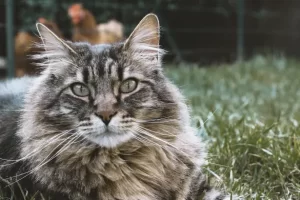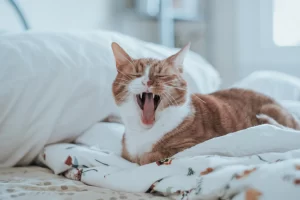Last updated on February 19th, 2023 at 11:03 pm

As cat owners, we are always curious about what’s happening with our cats, and we often want to know almost everything, just in case. Cat Dander vs Dandruff is one of the most common debates among cat owners. Sometimes, you’re just petting your cat when you notice a little dry skin dandruff all over her silky coat. Is it, however, dandruff or dander? How do you get rid of it? Of course, before anything else, the first thing you have to do is to know the difference between cat dander vs dandruff.
There is often some confusion between cat dander and dandruff on a cat, but the distinction is not difficult to make. Cat dandruff, like human dandruff, consists of visible white flakes of dead skin. On the other hand, Dander is microscopic and completely natural in cats. Don’t worry. We are here to assist you in regard to the information you need. In this article, we will talk about the difference between cat dander vs dandruff. Read on to learn more about the differences.
What is a Cat Dander?
Dander is the dead skin cells that our cats shed, but how does it become an allergen? The truth is that dander is not an allergen in and of itself. Instead, it serves as a vehicle for two different allergens. These allergens are referred to as Fel d 1 and Fel d 4.
Proteins are Fel d 1 and Fel d 4. Fel d 1 is produced by your cat’s skin and sebaceous glands, where it comes into contact with dying skin cells. Fel d 4 is, on the other hand, produced within saliva. When your cat grooms, his saliva mixes with his dander, which means the Fel d 4 protein could be transmitted through the dander.
When allergens are absorbed in the dander, they are shed along with the fur. Allergens may be released into the environment as a result of this shedding. As a result, you are not reacting to the dander or hair if you have a cat allergy. You are reacting to the proteins found in the dander. Pet allergies can be mistaken for seasonal allergies. Itchy throat, watery eyes, nasal congestion, swelling, and sneezing are all symptoms. Some people may experience wheezing and difficulty breathing in more severe cases. You may also notice skin changes such as itchiness, eczema, or hives.
How Much Dander Does Your Cat Expel?
If you’re wondering how much dander your cat produces, it’s a difficult question to answer. The first issue is that dander cannot be seen with the naked eye. The second issue is that it is impossible to know or measure how much dander a cat produces. The only true test, which is very unfortunate for the sufferer, is to see how badly someone with a cat allergy is affected. We don’t want that, don’t we? That’s why we don’t usually measure how much dander a cat expels as it is very complicated.
What are the Symptoms of Dander?
Cats won’t show any symptoms of dander. Because cat dander is microscopic, no symptoms are associated with it. Consider it in the same way that you would consider your own skin. You don’t see skin cells flaking off because your new skin cells push the old ones away. If you are, this is unusual and needs to be addressed. The same is true for your cat! No visible skin or cells will come off your cat if you only deal with dander. If you notice skin flaking off, this should be investigated further as it may be dandruff, but it is not a symptom of cat dander.
How to Treat It?
Nothing! The presence of dander on your cat is perfectly normal and is not something that you should try to change in any way. If you are allergic to your cat, certain foods, shampoos, and other products may reduce the amount of dander produced by your cat, thereby reducing the likelihood that they will cause you to experience allergic reactions. However, because dander is a normal part of a cat’s body that works to maintain the health of the skin and coat, you will not be able to resolve the issue of your cat having dander completely.
What is a Dandruff?
Dandruff is a fancy medical term for dead skin cells that flake off the skin of cats. According to Royal Canin, dandruff on a cat will appear as white flakes. Dandruff is frequently accompanied by excessive itchiness and even hair loss.
The white flakes could also spread to pet owners’ clothes or bedding. Regular dandruff should be distinguished from “walking dandruff,” which is caused by parasitic Cheyletiella mites (they look like dandruff but move quickly and are larger than regular mites).
Cat dandruff, also known as “feline dandruff,” is a skin condition in which your cat’s skin flakes. It appears as gray or white flakes on the skin and hair of the cat.
Most dandruff cases aren’t serious, and the condition can improve with treatment. However, the presence of dandruff can sometimes indicate a serious health problem.
What are the Symptoms of Cat Dandruff?
If you notice flakes in your cat’s fur, there are a few things to look out for. Sometimes dandruff symptoms and other symptoms are combined, which can help you figure out what’s causing the problem. When it comes to dandruff, the most noticeable symptom is flaking skin. The presence of larger flakes in the fur can indicate various problems.
There may not be much redness with typical dandruff. However, more severe dandruff symptoms, such as red and irritated patches, can sometimes appear. If you notice this type of problem, it is critical to determine the cause because scratching can cause bleeding and infections. In some cases, you may notice areas of skin that are thicker or even scaly in addition to dandruff.
These are important to keep in mind as you investigate the source of the problem. When your cat’s dandruff is severe, it could signify mites rather than dry skin. Cheyletiella mites, also known as “walking dandruff,” can cause severe dandruff and mange in cats. If you suspect that these mites are to blame, you should consult a veterinarian.
How to Treat It?
Your cat’s dandruff treatment options will differ depending on the condition’s underlying cause. It may be necessary to brush cats that do not properly groom themselves regularly, and some of these cats may even require baths with specialized shampoos that promote skin health. Some cats respond positively to omega fatty acid supplementation when added to their food.
Because dandruff can be caused by skin parasites and skin infections, it is essential to consult with your veterinarian if your cat develops dandruff. This is especially true if your cat has no previous history of problems with its skin or coat. They will be able to assist you in narrowing down the potential causes of your cat’s dandruff and assisting you in developing a treatment plan for your cat.
Cat Dander vs Dandruff: What’s the Main Difference?
Now that we discussed them separately, we can answer this article’s main question. What’s the main difference? Cat Dander are microscopic, meaning you can’t see it, and it doesn’t show any symptoms in cats. Usually, the symptoms are shown in the people around the cat. People who are allergic to Fel d 1 react by producing immunoglobulin E (IgE) antibodies, according to the scientific explanation of nature.com. These cause mast cells to release histamine and other chemicals, resulting in sneezing, itching, and congestion. Sneezing is the most common symptom of a cat dander allergy, but it can also cause watery eyes, a runny nose, and breathing difficulties. It can even trigger an asthma attack in severe cases.
Where things get, a little murky is that dandruff can contain dander, so many people mistake white flakes on or from their cats for dander. However, an important distinction is that dander, not dandruff, causes allergies in some people. Dandruff is usually associated with dry skin and dehydration in cats. It also causes itch and redness.
If you notice that your cat has flaky and dry skin, consult your vet for immediate treatment, as dandruff can signify something more serious.
When determining whether your cat has dander or dandruff, consider his or her overall health and appearance. A small area of flaky skin will most likely require a different treatment than your cat’s skin being flaky all over. If your cat has no flakiness but appears itchy or uncomfortable on its skin, you should look for causes such as fleas and sensitivity to topical medications. It is not necessary for visible flakiness and irritation in the skin to indicate a problem.
Dandruff and dander are two very different things, but they have one thing in common! They both make ours and our pets’ lives miserable. That’s why we have to do our very best to control it. Dander is not visible, but it is the source of allergies, whereas dandruff is simply dry, flaky skin that you can see in your cat’s coat. Cat dandruff can be eliminated by brushing them regularly, increasing the humidity in your home, and changing their diet. You’ll have to live with dander, but you can reduce it by brushing your cat and increasing your cleaning schedule.
Conclusion
The debate on cat dander vs dandruff may seem like a never-ending series of questions, but believe it or not, the answer isn’t quite complicated. As we discussed earlier in this article, dander and dandruff are easy to distinguish; the only confusion is that sometimes, dandruff contains dander.
Dander is microscopic, it cannot be seen by the naked eye, so it will be impossible for you to see symptoms in your cats. However, if you have or you know someone with cat allergies, you’ll see that it will get worse when you or they come closer to your cat. On the other hand, dandruff is easier to distinguish. You can see flaky skin, sometimes associated with dry and red skin. If you notice these common symptoms, talk with your veterinarian as soon as possible.


